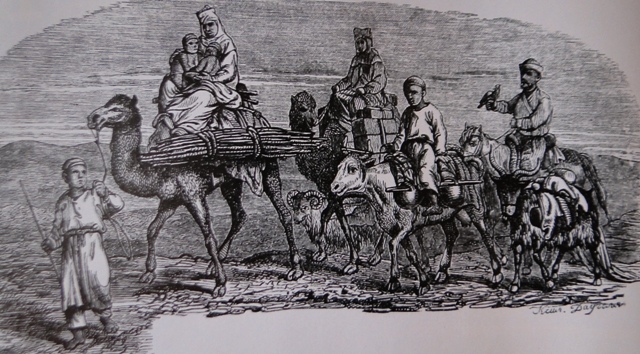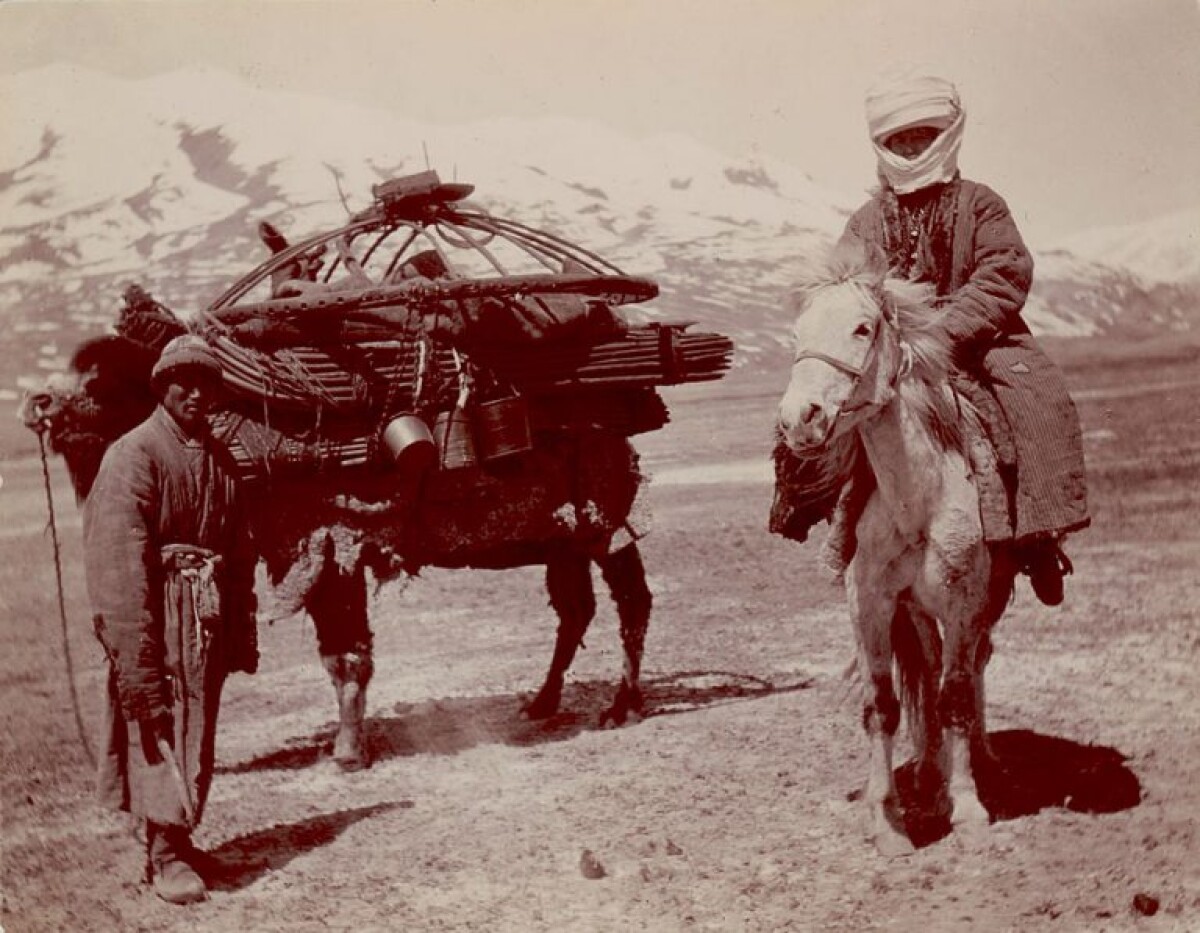
of its development. During its three-thousand-year history, the nomadic society has passed a long evolutionary path. The Kazakh nomadic society in the system of world nomadism created high patterns of economic, socio-political and cultural-domestic ethnic life. The problem of studying the civilizations of nomads is one of the topical in the modern historiography of Kazakhstan and at the same time complex.
Some scholars denied the role of the Turkic-Mongolian nomadic peoples in the world history. This direction in historical science, connected with the dominant role of European nations and a biased underestimation of the level of development of nomadic civilizations of the East, is called Eurocentrism. The peoples who led a settled way of life wrote about nomads, they were described by Herodotus, Chinese historians. The theory of nomadism and the nomadic state arose later.
Until the beginning of the sixteenth century, the Western people were aware of nomads only on their periodic invasions of Europe, they perceived nomadic peoples as their enemies. European scientists expressed their opinion about nomads. For instance, some scientists regarded them as just and free people of a free society, whereas others argued that the nomadic property and social inequality manifested itself first. It was concluded that the state itself as such arose as a result of a clash of nomads and sedentary people. A prominent philosopher Hegel believed that, despite the presence of nomadic social contradictions, they did not have statehood. And although the views of scientists were different, but more emphasis was placed on the negative aspects of the life of the nomadic society.
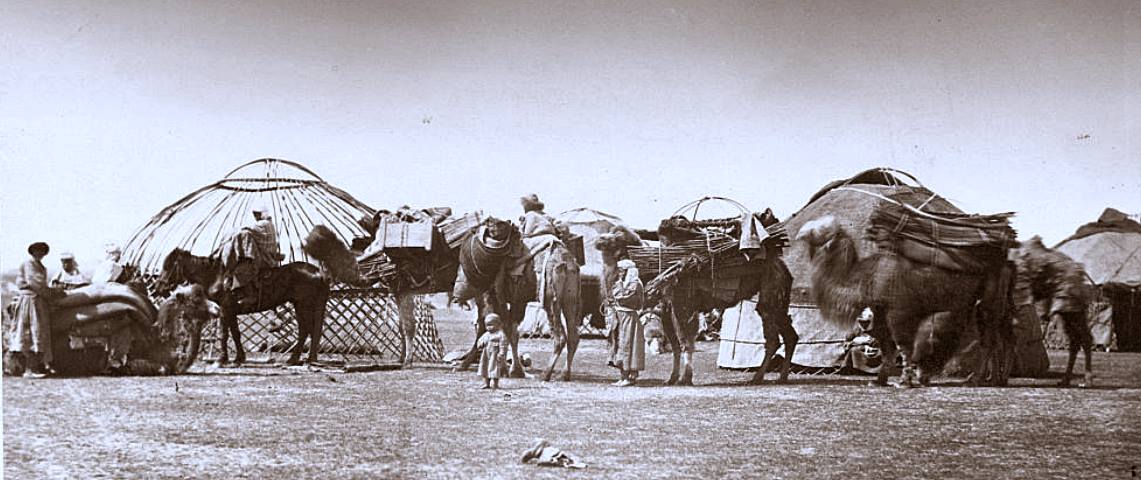
For example, scientists such as Thornwald and Toynbee believed that nomads could not create a civilized society and a state without outside help. According to most researchers, nomadic communities without the help of a sedentary population will not be able to develop. Since the beginning of the 20th century, the nomadic civilization has become the subject of special research. In the middle of the same century, individual scientists began to recognize the objective nature of the emergence of the nomadic way of life due to geographical, economic and other factors. This was not a retreat from the road to civilization, but was a peculiar way of economic and economic development. Adapting to the peculiarities of the natural and geographical environment, the nomads were forced to engage in cattle breeding. With the increase in the number of livestock, they had to constantly move in search of new pastures, which led to the emergence of a nomadic way of life.
According to a number of scholars, nomads independently reached the first stages of class society, and their further development depends on the influence of sedentary peoples, that is, the nomadic society is a socio-historical association with limited development prospects. Nevertheless, in recent years, more and more often have been heard statements emphasizing the high level of culture and dignity of the social structure of ancient and medieval nomadic associations. With the opinion that the nomadic civilization is a natural phenomenon in the history of mankind, a kind of economic activity, culture and lifestyle, most scholars agree. As another camp of academics claim, in the territory of Kazakhstan, the nomadic pastoral system was formed in the ancient times. The term 'nomads' implies the people who are engaged in nomadic cattle breeding.
The large territory of Eurasia does not have internal geographic boundaries separating different regions. The steppe, separated by rivers, stretches from the Carpathians and the Northern Black Sea coast almost to the Pacific Ocean. Here survival directly depended on the expansion of the living space. Steppe peoples were not shielded from their neighbors by difficult geographical obstacles, like European states. The opportunities for rapid movement in space, provided by the way of life, required constant expansion of the territory. In different epochs due to climate change, and also due to the constantly changing ethnic and socioeconomic situation in these regions, then settled, then semi-settled, then completely nomadic ways of doing business and organizing everyday life prevailed. The population of steppe, desert and semi-desert lands, foothills engaged in cattle-breeding, as it is the most convenient way in these natural and geographical conditions to satisfy vital needs. Aboriginal cattle breeders were Kazakhs who roamed the vast desert and semi-desert areas.
Originally cattle-breeding was a type of a homework, when cattle were grazing near the settlement. Further development of this type of activity causes disagreements and disputes among scientists. Thus, some believe that in connection with the increase in the number of livestock, homemade livestock production has become unprofitable, as gradually the pastures trampled down and skimmed. People were forced to move the settlement to a new place in search of unused pastures. The millennial practice of growing livestock has led to a new, more profitable and convenient form of cattle-breeding - transhumance. It was transhumance cattle breeding that became an intermediate link in the transition to a more productive way of developing steppe and desert pastures-nomadic farming. So a nomadic way of life was born. Nomadic cattle breeding is one of the most peculiar kinds of human activity, which has changed very little since its inception. Its inherent features: Firstly, cattle-breeding is the main activity. Agriculture and crafts do not play a serious role for nomads. Then, it is said that cattle is not kept in stalls throughout a year, but in nature - at the stern. Thirdly, periodic movement of people and livestock within established pasture territories. Fourthly, the participation in the migration of all or most of the population. Finally, the economy is aimed at satisfying its own vital needs, and not for sale.
When it comes to military art of nomads, it should be noted that the protection of their lands from neighbors and the conquest of new pastures demanded a high level of military training from the nomads. According to Herodotus, no one could conquer the Scythian army, they suddenly appeared, struck and also quickly disappeared. It was customary before the expedition that the Scythians would sit on the skins of sacrificial animals. It was believed that gives the warrior masculinity and strength. The nomads had their own army structure, which consisted of scouts, mounted troops, foot troops and heavily armed troops. The horses and riders were dressed in iron and bronze armor. Horse and foot troops acted together. Prior to approaching the enemy, foot soldiers were behind the backs of the horsemen. First they fired poisoned arrows, and then used axes, peaks and daggers. The warrior was supposed to have five types of weapons. Nomadic society constantly improved the leadership of the army, its structure, military weapons, improved supplies, food, checked the readiness of the military to archery, taught military tactics and combat strategies. Particular attention was paid to the tactics of fighting: two phalanges and a central part. This division of the army was particularly successful in the Turkic era. The army consisted of five tribes. In the course of military operations, if necessary, the construction of the army changed. The nomads had their own banners.
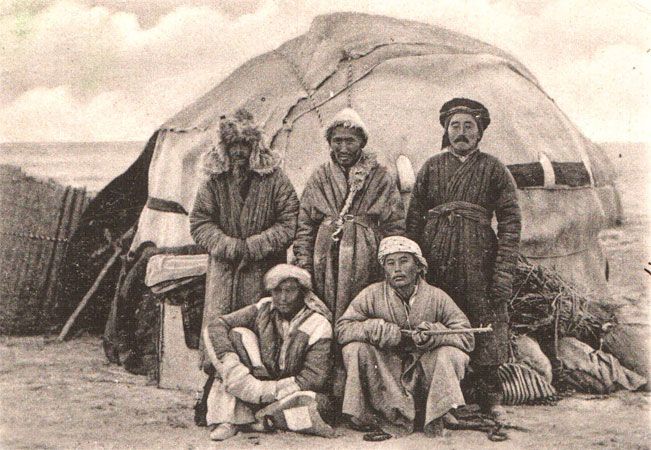
Despite the fact that the formation of nomadic, semi-nomadic and sedentary types of economy in Kazakhstan, its roots go back to ancient times; the development of these types of economy in different climatic conditions took place simultaneously, albeit at various rates and never stopped, the Kazakhs, by inertia, continue to be considered typical nomads who had nothing in common with settled life, agriculture and even more so urban civilization. At the same time, one does not take into account the fact that the basis for the formation, even the existence of three Kazakh zhuzes - the senior, middle and younger - was one or another oasis, where cities, settled agricultural settlements were located, whose inhabitants were engaged not only in trade and crafts affairs, but also cattle breeding, irrigated by agriculture, even if it is unproductive. Not always and not necessarily the herdsmen of the steppes and farmers of neighboring oases were ethnically different populations.
Throughout history, as part of the same nomadic people or tribal unification, some part of it was semi-nomadic and even sedentary. Scholars suggest that the elements of settled life and agriculture always accompany nomadic cattle-breeding. Having their relatives on the banks of the Syrdarya, in the valleys of Talas, Keles, Arys, Chirchik, the basin of famous Zhetisu, nomadic cattle-breeders maintained regular and sufficiently strong economic ties with them, as evidenced by excavations at Otyrar and other medieval settlements. In exchange for sheep, horses, camels, wool, furs, skins, skins, nomads received in oases bread, which along with meat and dairy products formed the basis of their food, as well as cloth, dishes, weapons. In such contacts, the population of oases was also interested, which received the necessary products from the steppes.
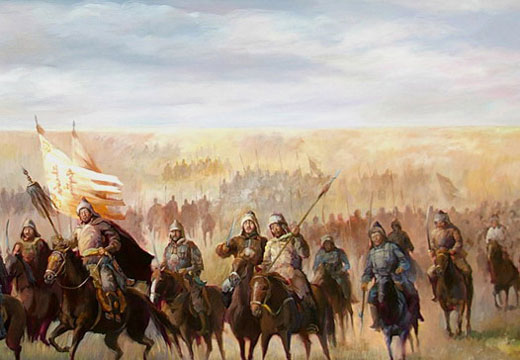
Kazakhs have repeatedly reflected the onslaught of Central Asian rulers who had always sought to settle Syganak, Sauran, Yasy, Sozaq, Otyrar, Sairam and others. These areas were extremely important for the Kazakh khans, the leaders of the nomadic Uzbeks, the rulers of Mogulistan and Maverannahr, both economically, being an area of developed agriculture, beautiful winter pastures, craft and trade, and in the military-strategic. Between them there was a continuing struggle for dominance over this area throughout the sixteenth century.
Approximately from this time until the first quarter of the eighteenth century, that is, before the invasion of the Dzungars, the abovementioned cities submitted to the Kazakh rulers who, relying on their fellow tribesmen as a military force, felt themselves as the masters of this region and received considerable revenues from the urban trade and craft population and neighboring dekhan - farmers in the form of taxes and duties. Therefore, when assessing the economy of the Kazakhs of the past, it is obvious, it is necessary to proceed from what form it prevailed in this or that region and in what proportions it was combined with others. In the steppes of Saryarka, for example, Kazakhs bred large numbers of sheep, horses, camels, which were kept at the forage and constantly needed to change pastures. Due to this circumstance, large cattle owners were forced to migrate to long distances, whereas relatively small-scale steppe inhabitants had only one, two or three days' passage to hold out on near pastures.
At the same time, both of them willingly exploited the harvesters - the most deprived part of the steppe population of the late Middle Ages, forced to settle for the lack of their own livestock. Harvester were engaged in the construction and repair of winter parking lots - qystau, with their residential and household buildings, hay preparation for Bai cattle, which was not always enough for the winter, primitive farming at river sites, around fresh lakes. All the wealth of the harvesters consisted, as a rule, of one or two dairy cows, a camel and a horse as draft power. They had almost no sheep and goats. The nomadic steppe-dweller eats, drinks and clothes cattle and for him/her livestock is more expensive than its tranquility. The first greeting of the Kazakh, as you know, begins with the following phrase: "Is your livestock and your family well?" This concern, which in advance is informed about livestock, characterizes more than whole pages. And the welfare of the cattle - the main wealth of the steppe people depended entirely on the natural conditions, according to which the seasonal pastures were historically formed.
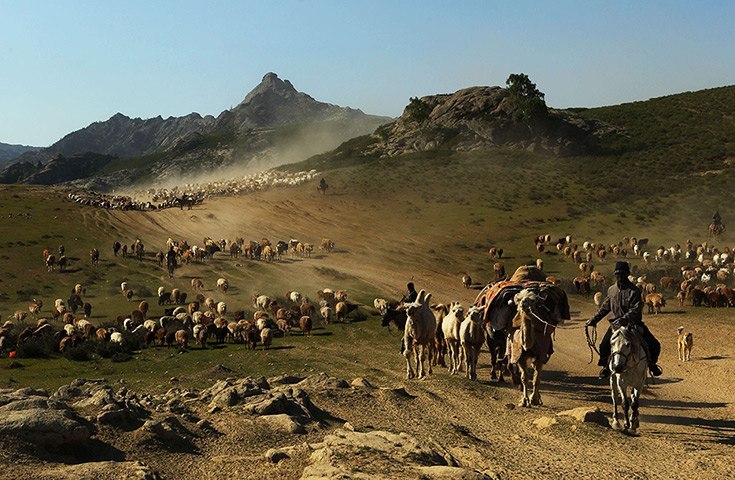
The northern forest-steppe and southeastern highlands of Kazakhstan, where a significant amount of precipitation fell out, were used mainly for summer pastures -zhailau, eastern and central for winter - qystau. But spring - cocktail and autumn - the pasture cousin directly adjoined to the wintering areas. Seasonal pastures, although traditionally distributed among the genera, were, with the exception of winter, in general use. The Kazakhs are characterized by all kinds of roaming known in history - the so-called meridian, vertical, and wintering, determined primarily by the number of cattle on farms, natural and climatic conditions in which there were certain groups of nomadic herders.
And nomads and semi-nomads had their own separate winter camps, with guarded areas for grazing young animals, weak animals. They were called koryk or koi bolik. More independent livestock owners also had spare winter quarters - kelte kystau, jargan bark and part of their livestock kept in the stalls in winter. Summer camps of Kazakhs of middle and junior zhuzes were located in the forest-steppe and steppe zone of the Saryarka, winter - in the floodplains of the Syrdarya, the lower reaches of Shu, at the foot of Qaratau, in Aral Sea and Mangyshlak. From early spring, following the coming warmth, the nomadic people started moving northward. The Kazakhs of the southern part of the Saryarka steppes, which not only in the summer but also in the winter led a nomadic life in the lower reaches of the Shu, passed only one way up to a thousand kilometers from the Shu river, through Betpaq aala, Ulytau mountains to the present Atbasar. The nomadic population of the right bank of the Syrdarya moved north through the Karakum, Aynakul to Turgai and further to Kostanay.
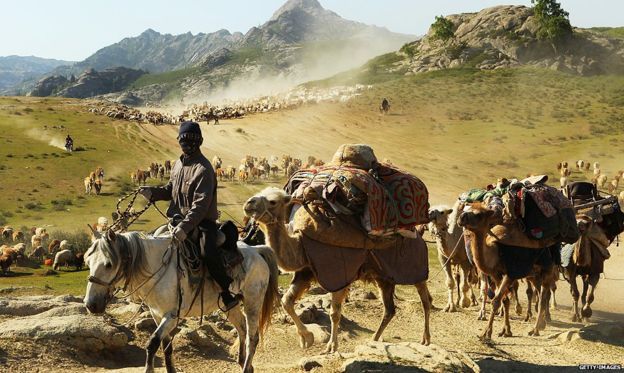
From the Ustyurt and Mangyshlak plateau, the lower reaches of the Urals, the shores of Oyil, Saghiz, Yrgyz, where summer pastures were scarce, people migrated over the summer to the present Ural, Aktobe and Kostanay regions, overcoming thousands of kilometers one way. However, many households moved within their ancestral lands. And low-income farms or impoverished people also stayed in winter camps. The number of such farms in the early twentieth century. was quite large even in such purely nomadic pastoral areas as Mangyshlak and Ustyurt, the lower reaches of the Syrdarya. Thus, numerous herds of cattle of Kazakhs of middle and junior zhuzes were in the summer of Torgai, Ural and Aktobe pastures. And with approach of autumn, after the departing heat they moved back to the south, to the places of wintering. The routes of such migrations were regulated primarily by the location of water sources.
Kazakh nomads usually migrated with a mobile village, connected by kinship ties or economic benefits, adhering, in order to avoid collisions with neighbors, the same tracts, wells. In the tracts with an abundance of grass, a good watering place aul was located for several days, and if conditions permit, and more. In the deserted deserts with a scarce grass stand, the parking was reduced to two or three days. This kind of nomadism among the Kazakhs is considered to be meridian from the south to the north and from the north to the south. For the Kazakhs of the senior Zhuz, the foothills and mountains of Altai, Tarbagatai, Dzhungar, and Talas Alatau served as summer camps. They wintered usually in the sands of Moyinqum and other valleys that protected them from cold winds, wherever there was not much snow and cattle could get food. In the spring, rising gradually into the mountains, the nomadic brought their herds to the alpine meadows, where the cattle was all summer.
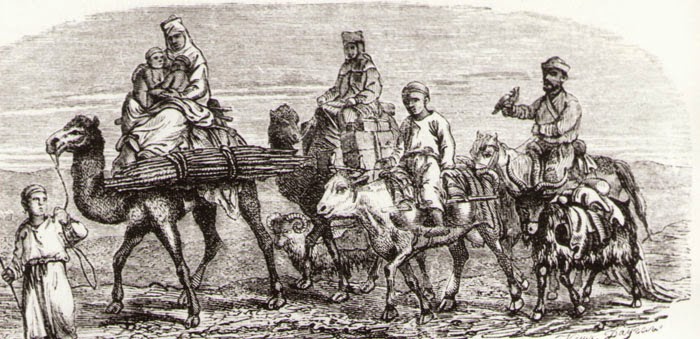
By autumn, all the herds were lowered again. This is the so-called vertical nomadism, with its somewhat less extended, compared with the meridian, transitions. The third, the so-called 'wintering' nomadism, was typical for the arid regions of southern Kazakhstan. Winter-nomadic cattle-breeders were conducted in villages located in areas of irrigated agriculture, where their manors were located with a small supply of hay, so that they could keep a small number of cattle. And the main herds wintered in tugai, reed beds of the Syrdarya floodplain, Talas, and Shu, where animals could themselves obtain food. In the spring, the more well-off cattle-breeders traveled with their herds for short distances on both sides of the Syrdarya, along the Karatau, Talas and Alatau, settling in the summer near lakes, wells, and returning to winter in late autumn. The distance to the summits was within forty or fifty kilometers.
For all types of nomadic nomadic activity, the species composition of the cattle was characteristic. During the so called meridian system of nomadic migration, there were a lot of sheep, horses, camels, especially bunnies, capable of independently to take food and suffer the difficulties of a long transition. Sequential movement through seasonal pastures was a single production process, in which nomadism acted as a stage of its closed annual cycle.
Despite the difficulties of the transition, summer migrations are the best that the steppe could experience in life, when the cattle on the summer fodder quickly gaining weight, you can enjoy fresh meat, milk and koumiss, spend blithely a few months in the open air under clear air. It's time for weddings, competitions in songs, dexterity, strength. And because a generous summer with its colorful moves was sung in songs, an epic poem 'Kyz-Zhibek' with all the colors of versification. In all likelihood, it is from those far times that the Kazakhs tradition remained to adorn carpets of a laden camel lovingly, for which they specially made embroideries with embroidery and all kinds of pendants. A caravan of loaded camels was usually driven by a girl in a rich outfit on a pony horse or on a camel head.
The nomadic way of life left an imprint on the spiritual world of the Kazakhs, worldview, customs and traditions. Over the long history of the development of the Kazakh culture a rich spiritual heritage has been formed. Like many nomadic peoples, the Kazakhs are characterized by an oral transmission of information through the means of myths, legends, tales, epics, shezhire. The nomads jealously guarded their cultural traditions and practically did not allow the influence of cultures of other ethnic groups, thereby preserving the spiritual basis of the trait, which we can observe today.
The life of the nomads was due to the harsh living conditions: human adaptation to the harsh climate, pasture turnover, lack of water sources, threats of attack by opponents, care for livestock. Cattle from the Kazakhs is a value, as evidenced by the abundance of proverbs. The complexity of the nomadic lifestyle influenced the upbringing of the younger generation. For centuries, the patriarchal Kazakh family has shaped social foundations and traditional values, which consisted in a moral attitude to nature, to the world around, in respect for the mother woman, as a custodian of the hearth, and in the cult of veneration of the father, as head of the family and continuer of the family, in reverence the spirit of the ancestors - Aruah and in a respectful attitude to the memory of previous generations.
The Kazakh family had a multi-level structure, usually lived together for people of several generations - grandparents, fathers and mothers, unmarried uncles and aunts, children. The influence of old people on the upbringing of the younger generation in Kazakh society is great. Traditions developed by centuries, passed down from generation to generation. The ban on marriage on the seventh knee remains sacred, despite the spread of Shari'a, which allows close relatives. Since childhood, the Kazakhs knew their ancestry up to the seventh generation well; the elder relatives, the aksakals, followed this.
The parental yurt was considered a sacred place for children: the fire from the parental hearth was handed over to the son when he acquired a family. The daughter, having married and having given birth to the first-born, was obliged to come to an ancestral home with the first-born. Daughters-in-law and daughter-in-law entering the yurt of her husband's parents, must have bowed, in deference to their ancestors. The attitude to the child in the Kazakh family is very reverent, and the firstborn was given a special position. Many rituals based on centuries-old experience and ancient beliefs are associated with the birth and upbringing of children. The event associated with the birth of a son was solemn, and often went beyond purely family joy. On the birthday of the child, the aul youth gathered and had fun until the morning, it was believed that the noisy fun scared away the evil forces.
There were differences in the education of girls and boys. Nomad children grew up very early. At the age of thirteen and fifteen, children were considered adults, were allowed to take part in social gatherings, and actively participated in economic and production activities. After all, a nomadic way of life required men to be, above all, a earner, warrior, protector of the tribe. Such qualities as courage, endurance, diligence were inculcated. At the age of five and six, Kazakh boys were trained to look after lambs, prepare firewood, make tools from livestock production (weaving bridles, whips, shider, making leather, making weapons). Along with teaching and work, the game belongs to special types of human activity. Holidays and games that performed educational, military-sports, ritual, aesthetic and communicative functions had a great social significance in the life of the Kazakhs. Equestrian competitions and games developed in young people strength, agility, courage. Also with the development of military-applied art, archery competitions developed. Wrestling was very popular among the people, the youth games kyz kuu, altybakan, aksuyek and baiga were very entertaining and usually took place during major holidays and celebrations.
As soon as the son started a family, he was separated into an independent household. Several families formed an aul, and several auls, the nomads of which were connected by blood ties to the seventh generation, formed a subgenus. fifteen to twenty subgenera formed a clan, etc. Such co-habitation of relatives increased the chances of nomadic survival. Since the early childhood, the responsibility for housekeeping was placed on the shoulders of future men. Typically, the Kazakh children had certain responsibilities in the family, for which they were fully responsible to the head of the family - the father. The boys actively helped the mother, whose cult was sacred in the Kazakh family. Nomadic men often had to be out of the family: to explore new pasture lands, to graze cattle, to do patrol service, to fight with opponents.
Women did housekeeping, were responsible for the welfare of the family, raised children, looked after old men, received guests, often looked after cattle on an equal basis with men. Women also owned sewing, weaving, felting, carpet weaving. Great attention in the Kazakh family was given to the education of girls - future mothers. On the one hand, girls were brought up in an atmosphere of love, tenderness, morality. Kazakh girls should have such qualities as tenderness, modesty, good nature. On the other hand, the girls were prepared to fulfill the roles of “mother”, “Kelіn” - “Hostess of the hearth”. Such social roles demanded physical fitness, perseverance, diligence and patience from girls.
From five or six years of age, girls learned from their older sisters, mothers and grandmothers in women's crafts, cooking, preparing food, etc. From simple sewing operations, they proceeded to learning how to make products from felt, weaving, weaving mats. Before marriage, the girl had to weave a carpet with her own hands. Usually, women of her kind helped her. In the parental home, the girl had to learn the rules for receiving guests, because hospitality is a special ritual typical of the nomadic way of life. Kazakh girls learned to properly set up dastarkhan, prepare treats, pour out tea, behave modestly with guests, be laconic. By the age of thirteen and fourteen, they were already fully prepared for independent living, since for thirteen years, the Kazakhs are considered to be the age of maturity.
Thus, the upbringing of children and young people in a nomadic way of life was exclusively practical. Early familiarization with work, independence, physical endurance, attentiveness to a natural phenomenon, knowledge of crafts and trades, traditions and customs is the basis of the educational process. Young people had to become worthy members of a large team of relatives, pride and protectors of the family. It should be noted that the wise approach of ancestors in matters of education, not only ensured the existence of the Kazakhs as an ethnic group, but also allowed to preserve many traditions and customs to this day.

